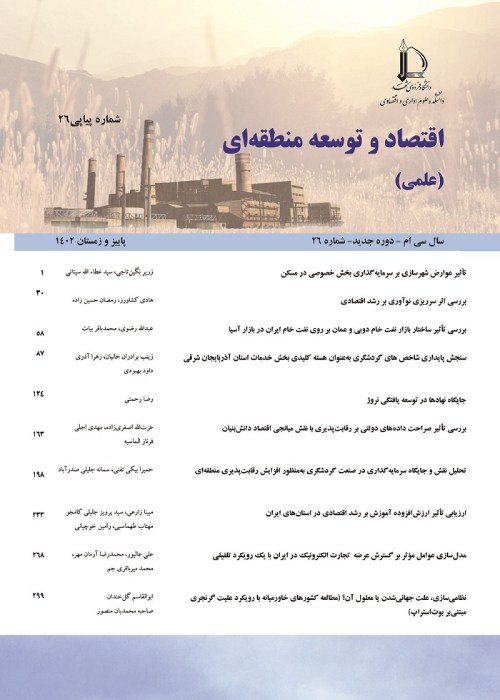Economic Justice and Social Crimes; Some Evidence from Iran's Provinces
The main keys that influence crime rates are examined from two economic and sociological points of view. Preventing crime is one of the requirements of any healthy society. Economic inequalities and unfair distribution can be the main reasons of crimes. The complexity of the relationship between justice and fairness on the one hand and the indicators of the distribution of economic benefits from the other hand admit the essentiality of the examining relationship between income inequality and crime rates. Recent researches have shown that income inequalities and economic discrimination are among the top priority factors that affect social crimes. This research studies the effect of various economic justice indicators on crime rates in the provinces of Iran.
Theoretical frame work:
Studies show that the economic situation has significant effects on individual activities, including crime. In addition, the feeling of being deprived of success and exacerbating this feeling in relation to successful people (the existence of inequality) can be a source of criminal behavior (Stolzenberg et al., 2006).People who are frustrated by their failures in their community become more annoying when confronted with successful people around them. According to this theory, poor people in a situation of high inequality are more likely to commit criminal acts (Enamorado, et al., 2016).The sense of deprivation can be due to various factors such as belonging to an ethnic minority, Ethnic heterogeneity, or income inequality. Runciman& Runciman, (1966) argues in the theory of relative deprivation that income inequality has created a sense of expropriation in one person and increases injustice, thereby increasing the amount of crime committed by increasing inequality of income (Rufrancos et al., 2013). Economic and social inequalities increase the crime rate by weakening social integration and increasing the social class gap (Wilkinson & Pickett, 2010).
Choe (2008) shows that the amount of crime in the past period has a great effect on the crimes of the current period. Therefore, to test the hypotheses, the GMM Arellano and Bond (1991) method is used to estimate the model. The following models are estimated for 28 provinces of Iran during the period 2000-2015.Where is the number of crimes divided by province population, represents the Gini coefficient, is discrimination indicator from a capacity viewpoint, is discrimination indicator from a need viewpoint and is the average of and .Economic discrimination index is the province's current and capital government budget divided by the capacity share (population, value-added, and area), and share of needs (unemployment rate, illiteracy rate, and life expectancy) of each province[1]. expresses the unemployment rate, is per capita GDP, is government size (division of provincial government expenditures on provincial GDP) and is the urbanization rate (urban population divided by the total population).
The results of the estimation of regression models are presented in Table 1.The results indicated in Table 1 show that the effect of all indicators of economic inequality on crime is positive and significant. The effect of the unemployment rate and GDP per capita on crime is positive and significant in all four estimated models. The effect of government size on the crime rate is negative and significant in models 2-4. That means government spending has been increasing welfare and reducing inequality. The impact of urbanization rates on crime in all models is positive and significant. Results show that the impact of migrations to cities and the marginalization of households increase crime. The causality test also shows that all indicators of economic inequality are the statistical cause of crime, but there is no inverse relationship.
Conclusions and Suggestions:
The results show that there is a statistically significant relationship between crime and economic inequalities. Also, causality shows that in addition to statistical relationship, causality relationship also exists. Hence, reducing income inequality and economic discrimination is needed to reduce crime. Economic discrimination of government spending can also increase the rate of crime in the provinces. Therefore, governments should realize that the discriminatory spending of governments, in needs and talents viewpoint, can in addition to slow down economic progress, lead to social harms.The results show that government size had a negative impact on the crime rate. The relationship between unemployment and crime also indicates the importance of reducing unemployment in reducing crime rates. It seems that the positive relationship between economic growth and the crime rate was due to an increase in crime benefits because of rising incomes, and because the wealthy regions are due to the opportunities available for theft (which constitute a large amount of total crime) will attract more criminals (Khan et al., 2015). Finally, increasing the urbanization rate increases the crime rate. Immigration and marginalization of cities seem to have a damaging effect on the health of the community.
- حق عضویت دریافتی صرف حمایت از نشریات عضو و نگهداری، تکمیل و توسعه مگیران میشود.
- پرداخت حق اشتراک و دانلود مقالات اجازه بازنشر آن در سایر رسانههای چاپی و دیجیتال را به کاربر نمیدهد.


